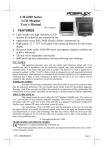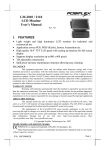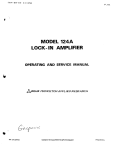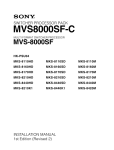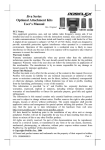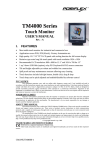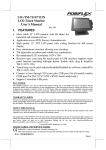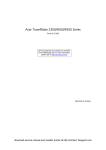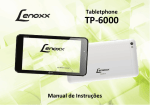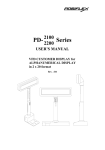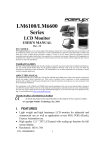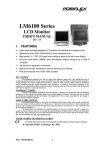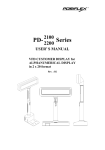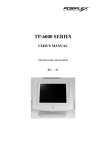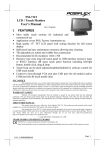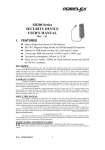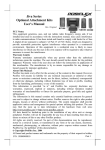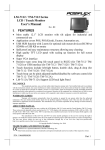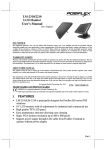Download LM4115 / TM4115 LCD / Touch Monitor
Transcript
LM4115 / TM4115 LCD / Touch Monitor USER’S MANUAL Rev. : Original I. FEATURES • Most stable touch monitor for industrial and commercial use • Application covers POS, POI (Kiosk), -Factory Automation etc. • High quality 15” TFT LCD panel with scaling function for full screen display • Spill proof and easy maintenance structure allowing easy cleaning • Tilt adjustable yet robust and wobble free construction • Recommended. LCD resolution: 1024 x 768 • Slim featured from any excessive option for its predecessor • Resistive type extra long life touch panel • Touch functions include left/right button, double click, drag & drop (for TM4115 only) • Touch beep can be pitch adjusted and enabled/disabled by software control (TM only) • Connect to host through VGA and COM port FCC NOTICE This equipment generates, uses, and can radiate radio frequency energy and, if not installed and used in accordance with the instructions manual, may cause interference to radio communications. It has been tested and found to comply with limits for a Class A digital device pursuant to subpart J of Part 15 of FCC Rules, which are designed to provide reasonable protection against interference when operated in a commercial environment. Operation of this equipment in a residential area is likely to cause interference in which case the user at his own expense will be required to take whatever measures to correct the interference. WARRANTY LIMITS Warranty will terminate automatically when the machine is opened by any person other than the authorized technicians. The user should consult his/her dealer for the problem happened. Warranty voids if the user does not follow the instructions in application of this merchandise. The manufacturer is by no means responsible for any damage or hazard caused by improper application. ABOUT THIS MANUAL This manual assists the user to utilize the LCD Monitor LM4115 and the TOUCH Monitor TM4115. This product provides exquisite touch control capability over a stable and adjustable LCD monitor with minimal footprint. The manufacturer of the LM4115 / TM4115 LCD / touch monitor heartily apologizes to the user for reserving the right to change or to modify this manual without notice due to the rapid and constant progress and improvement on science and technology. The user may always obtain the most up to date information through any of our web sites: http://www.posiflex.com.tw, http: //www.posiflexuk.com, http://www.posiflexusa.com. Copyright Posiflex Inc. 2004 TRADE MARKS AND SERVICE MARKS POSIFLEX is a registered trademark of Posiflex Inc.. Other brand and product names are trademarks and registered trademarks and service marks of their respective owners. P/N: 19640900000 1 II. CARTON CONTENTS 1. 2. 3. 4. 5. 6. 7. LCD or Touch Monitor (Main unit + Adjustable stand assembly) User’s Manual Plastic key for cable cover latch VGA cable: 20863136610 RS232 cable: 20863244210 (for TN4115 only) Posiflex Product Information CDROM (for TM4115 only) Power adaptor: 12 V DC ASP0P042WTB001 & power cord III. PARTS IDENTIFICATION A. FRONT VIEW Display Screen + Touch Panel Main Unit Adjustable Stand Assembly B. SIDE VIEWS Power on/off switch (Press on white dot to turn power on) Latch hole for cable cover Lock/release lever Push in this direction to adjust the tilt angle of the display panel 2 C. REAR VIEW Lock/release button to detach the main unit Cable cover Lock/release lever for tilt angle adjust Cable Exit IV. INPUT / OUTPUT PORTS VGA (RS232) RJ45 Jack (for TM4115 only) 12 V DC V. AVAILABLE OPTION ITEMS 1. Wall Mount Kit 2. Deluxe security device upgrade kit KP-110 with necessary extension cable(s) 3. Common security device upgrade kit SD-110 with necessary extension cable VI. INSTALLATION 1. Insert the tip of the plastic key into a latch hole on one side and turn this key counterclockwise to the end. Do the same on the opposite side. Take the key out of the hole before pulling out the cable cover. 2. Press down the lock/release button on back of stand assembly when lifting the main unit to separate it from the stand. Route all cables through the cable exit in bottom of stand assembly. (Open the metal plate first if necessary.) Make all the monitor end of cables to come out of the stand assembly like the right picture below. Hook the main unit back on stand assembly by matching the matching pegs to round part of matching holes and slide them down to slot part till the rear latch clicks. 3 Matching Pegs Matching Holes Round Part Slot Part Cable Cover Removal Hollow 3. Connect the 10 pin RJ45 plug end of the touch control cable to the jack till it clicks. Connect and screw fix the end with power connector of VGA cable to VGA port on TM4115. Connect the output plug from the power adaptor to the DC jack inside cable cover of TM4115. 4. Consolidate the cables and close and lock the cable cover by inserting and turning the latchkey clockwise. 5. Connect and screw fix the other end of touch control cable to an appropriate COM port and the VGA cable to VGA port of the host system. Check the specification of the power adaptor against the power socket then insert power cable from the power adaptor into the power socket. 6. Adjust for best viewing tilt angle then press the power switch down to turn on the LCD panel and proceed for touch driver installation. VII. UPGRADE KIT INSTALLATION TIPS For mounting the upgrade kits KP-110 or SD-110, the required extension cables will arrive as accessory. Connect these extension cables with the upgrade kit in the cable cover area and connect to the host together with the VGA and the touch interface cable. VIII. DRIVER INSTALLATION A. INSTALLATION (for TM4115 touch control) Please find in the attached Posiflex product information CDROM under subdirectory \Drivers\TM4_TM6\RS232 or \Drivers\TM4000\RS232 for RS232 interface touch controller driver. In case this subdirectory is not found in the CDROM received, please use identical driver from relevant product such as \Drivers\TP6000\Touch\RS232. In such subdirector y, please then find the proper descendant for the OS applied such as \RSTC_W9x for Win9x system. Click SETUP.EXE to install the driver into system and a utility program for touch calibration. Please select “SmartSet Serial Controller” as the controller type 4 during the installation process. Same approach applies for other operating system. If, for any reason, the user wants to remove the driver for the RS232 touch controller, please select “Monitor Mouse” in the program list for removal. B. SETUP/CALIBRATION (for TM4115 touch control) Once the RS232 touch controller driver is installed, the user can utilize it to calibrate the touch screen, define mouse button emulation modes, enable right button emulation or define the click sound’s tone and duration. Please go to “Control Panel” and select “Elo Touchscreen” to engage this utility. Most items in this utility should be easily understandable to average user. Followings are just some reminders on some items. Ÿ COM port – This port selection must match exactly the port touch control interface cable is connected to. Ÿ Align – This function engages 3 touch targets at left top, right bottom and right top consecutively for touch calibration. Ÿ Click on touch – This selection of touch button disables the double click function of a touch and a left click will be registered at the point where a touch on the screen is made even if the touch is dragged to other spot before release. Ÿ Click on release – This selection of touch button disables the double click function of a touch and a left click will be registered at the point where a touch is released from the screen. Ÿ Drag – This selection of touch button disables the double click function of a touch and a left click contact signal will be sent to the host when a touch is made and a left click release signal will be there for touch release. Ÿ Drag, Double click – This selection of touch button allows the screen touch to simulate the complete left button of a mouse. Ÿ Double click size – This adjustment (10 to 100 pixels) is available only when double click function of the touch is enabled. The larger the size is, the easier it is to take 2 consecutive taps on the touch screen at nearly same spot as double click. Ÿ Show right-click sticky button – This function is only applicable in Win98 environment. When this box is checked, there will be a large 5 icon on desktop simulating a mouse. After clicking the right button of the mouse in this icon, next touch on the screen will act like clicking the right button of a mouse. After this touch, it will automatically resume the left click function. C. APPLICATION With this touch controller driver, certain display mode like full screen display of Windows DOS box should be avoided. IX. LED INDICATION • • Green: standby Blue: power on When this touch monitor is turned ON, the LED lights in blue. When the VGA signal vanishes, the monitor shows “No signal” for a while and goes into standby mode and LED is green. However, the touch panel is still operational. X. OSD (ON SCREEN DISPLAY) SCREEN ADJUST FUNCTION A. OSD buttons Power/Standby LED “OSD” button: To enter OSD setup menu, or to perform function selected in OSD operation. “NXT” button: To go to next option function. “” “” button: To increase setting value. “” “” button: To decrease setting value. B. OSD functions Press “OSD” button with a normal display on the screen to activate the OSD functions (On Screen Display adjustment). The OSD window will pop up on the screen. On top part of this window is a Posiflex logo with the OSD firmware version indicated to its lower right. Below this area is a row of icons for main OSD menu. Below the main menu is a group of icons for submenu that corresponds to one icon selected in the main menu. An analysis of the video 6 signal on resolution and refresh rate will be displayed at the bottom. Applicable icons in the main menu and its subsequent menus are explained below. “MAIN MENU”: There are in total 5 icons in this menu: One of the 5 icons will be displayed in inverted color to indicate its relationship with the submenu below. Pressing “NXT” button will shift the selected icon one by one from left to right and then wrap around to the most left. Press “OSD” button to enter the selected sub menu. If there is no button for OSD setting is pressed within a period of time (about 5 seconds to 1 minute as programmed) the OSD window will disappear with all the adjusted parameters saved. Explanations on items in sub menu are as below. “BRIGHTNESS / CONTRAST ADJUST SUBMENU”: There are 3 icons in this submenu: Press “OSD” button to select item or return to main menu. Press “NXT” button to select among brightness, contrast and exit. “BRIGHTNESS ADJUST”: When this item is selected, there will be only the brightness icon with an adjustment indication bar under it between the main menu area and the video signal mode. Press “+” button to increase brightness. Press “-” to decrease. Press “OSD” button to save the current setting and return to “Brightness/Contrast submenu”. “CONTRAST ADJUST”: When this item is selected, there will be only the contrast icon with an adjustment indication bar under it between the main menu area and the video signal mode. Press “+” button to increase contrast. Press “-” to decrease. Press “OSD” button to save the current setting and return to “Brightness/Contrast submenu”. “EXIT”: Return to “Main menu”. “COLOR ADJUST SUBMENU”: There are 4 icons in this submenu: Press “OSD” button to select item or return to main menu. Press “NXT” button to select among auto color adjust, auto RGB reset, Color balance adjust and exit. “AUTO COLOR ADJUST”: Upon an “OSD” button press on this icon the monitor will perform an automatic color adjustment and exits the OSD window leaving 2 icons below at center of the screen. Press “NXT” button to switch the selection. Press “OSD” button to make the choice. “ACCEPT”: Accept the adjustment setting. “REJECT”: Decline the adjustment setting and return to previous setting. 7 “AUTO RGB RESET”: Upon an “OSD” button press on this icon the monitor will perform an automatic RGB reset and exits the OSD window leaving 2 icons below at center of the screen. Press “NXT” button to switch the selection. Press “OSD” button to make the choice. “ACCEPT”: Accept the reset result. “REJECT”: Decline the reset and return to previous setting. “COLOR BALANCE ADJUST”: When this item is selected, there will be 7 icons in this item: between main menu area and the video signal mode. Press “OSD” button to select an item or return to color adjust submenu. Press “NXT” button to select among separate color adjust, 4200K, 5000K, 6500K, 7500K, 9300K and exit. “SEPARATE COLOR ADJUST”: When this item is selected, there will be 3 adjustment indication bars between the main menu area and the video signal mode. Press “NXT” button to select among the 3 colors Red, Green and Blue respectively. Press “+” button to intensify that color. Press “-” to reduce. Press “OSD” button to save the current setting and return to “Color balance adjust submenu”. “4200K”: Pressing “OSD” button on this icon will set the color ba lance to a color temperature of 4200 degrees Kelvin. “5000K”: Pressing “OSD” button on this icon will set the color balance to a color temperature of 5000 degrees Kelvin. “6500K”: Pressing “OSD” button on this icon will set the color balance to a color temperature of 6500 degrees Kelvin. “7500K”: Pressing “OSD” button on this icon will set the color balance to a color temperature of 7500 degrees Kelvin. “9300K”: Pressing “OSD” button on this icon will set the color balance to a color temperature of 9300 degrees Kelvin. “EXIT”: Return to “Color adjust submenu”. “EXIT”: Return to “Main menu”. “GEOMETRY ADJUST SUBMENU”: There are 6 icons in this submenu: Press “OSD” button to select item or return to main menu. Press “NXT” button to select among auto geometry adjust, horizontal size, phase, horizontal position, vertical position and exit. 8 “AUTO GEOMETRY ADJUST”: Upon an “OSD” button press on this icon the monitor will perform an automatic geometry adjustment and exits the OSD window leaving 2 icons below at center of the screen. Press “NXT” button to switch the selection. Press “OSD” button to make the choice. “ACCEPT”: Accept the adjustment setting. “REJECT”: Decline the adjustment setting and return to previous setting. “HORIZONTAL SIZE”: When this item is selected, there will be only the horizontal size icon with an adjustment indication bar under it between the main menu area and the video signal mode. Press “+” button to increase horizontal size. Press “-” to decrease. Press “OSD” button to save the current setting and return to “Geometry adjust submenu”. “PHASE”: When this item is selected, there will be only the phase adjust icon with an adjustment indication bar under it between the main menu area and the video signal mode. Press “+” or “-” button to adjust the pixel synchronization phase for best picture display. Press “OSD” button to save the current setting and return to “Geometry adjust submenu”. “HORIZONTAL POSITION”: When this item is selected, there will be only the horizontal position icon with an adjustment indication bar under it between the main menu area and the video signal mode. Press “+” or “-” button to shift the screen display to right or left. Press “OSD” button to save the current setting and return to “Geometry adjust submenu”. “VERTICAL POSITION”: When this item is selected, there will be only the vertical position icon with an adjustment indication bar under it between the main menu area and the video signal mode. Press “+” button to shift up the screen display. Press “-” to shift down. Press “OSD” button to save the current setting and return to “Geometry adjust submenu”. “EXIT”: Return to “Main menu”. “TOOLS SUBMENU”: When this item is selected, there are 5 icons in this submenu: Press “OSD” button to select item or return to main menu. Press “NXT” button to select among OSD submenu, reset to default, phase, smoothness / sharpness adjust, mode select and exit. “OSD SUBMENU”: When this item is selected, there are 4 icons in this submenu: Press “OSD” button to select item or return to 9 main menu. Press “NXT” button to select among OSD time, OSD horizontal position, OSD vertical position and exit. “OSD TIME”: When this item is selected, there will be only the OSD time icon with an adjustment indication bar under it between the main menu area and the video signal mode. Press “+” or “-” button to adjust the waiting time for OSD operation before OSD termination between 5 to 60 seconds. Default is 30 seconds. Press “OSD” button to save the current setting and return to “OSD submenu”. “OSD HORIZONTAL POSITION”: When this item is selected, there will be only the vertical position icon with an adjustment indication bar under it between the main menu area and the video signal mode. Press “+” button to shift OSD window right. Press “-” to shift left. Press “OSD” button to save the current setting and return to “OSD submenu”. “OSD VERTICAL POSITION”: When this item is selected, there will be only the vertical position icon with an adjustment indication bar under it between the main menu area and the video signal mode. Press “+” button to move OSD window downward. Press “-” to go upward. Press “OSD” button to save the current setting and return to “OSD submenu”. “EXIT”: Return to “Tools submenu”. “RESET TO DEFAULT”: Pressing “OSD” button on this icon will set all parameters back to the status when the monitor left factory. “SMOOTHNESS / SHARPNESS ADJUST”: When this item is selected, there will be only the smoothness / sharpness adjust icon with an adjustment indication bar under it between the main menu area and the video signal mode. Press “+” button to increase smoothness of display (decrease sharpness). Press “-” to go the other way. Press “OSD” button to save the current setting and return to “OSD submenu”. “MODE SELECT”: Pressing “OSD” button on this icon will have no effect at all if the display mode is not one of the confusing modes. The confusing modes here mean 640 x 400 or 720 x 400 in display resolution as both mode have refresh rate of 70Hz, horizontal frequency of 37.9KHz 10 and pixel frequency of 31.5MHz making it impossible for automatic select. These modes are not used in normal Windows display. “EXIT”: Return to “Main menu”. “EXIT”: Exit OSD setup with all adjustment saved. XI. SUPPORTED DISPLAY MODES For video signals beyond the supported display modes, there will be a message “Out Of Range” on middle of screen. Maximum supported color depth is 18 bits or 262,144 colors. Supported display modes are as in the table: Display Resolution Refresh Rate (Hz) Horizontal Frequency (KHz) 640*400 70 37.9 60 31.5 640*480 72 37.9 75 37.5 720*400 70 37.9 56 35.1 60 37.9 800*600 72 48.1 75 46.9 60 48.4 1024*768 70 56.5 75 60 XII. TROUBLE SHOOTING In case of any malfunction, please check the following points in sequence to resolve it. 1. If there is no power indication, please check the power connection. 2. If there is no picture display with power LED on, please check the video signal connection. 3. If there is no touch function, please check the connection of the RS232 cable (20863244210) for RS232 interface touch controller. Please pay particular attention on whether the RS232 cable is connected to the right COM port of PC according to the driver installation. 11











